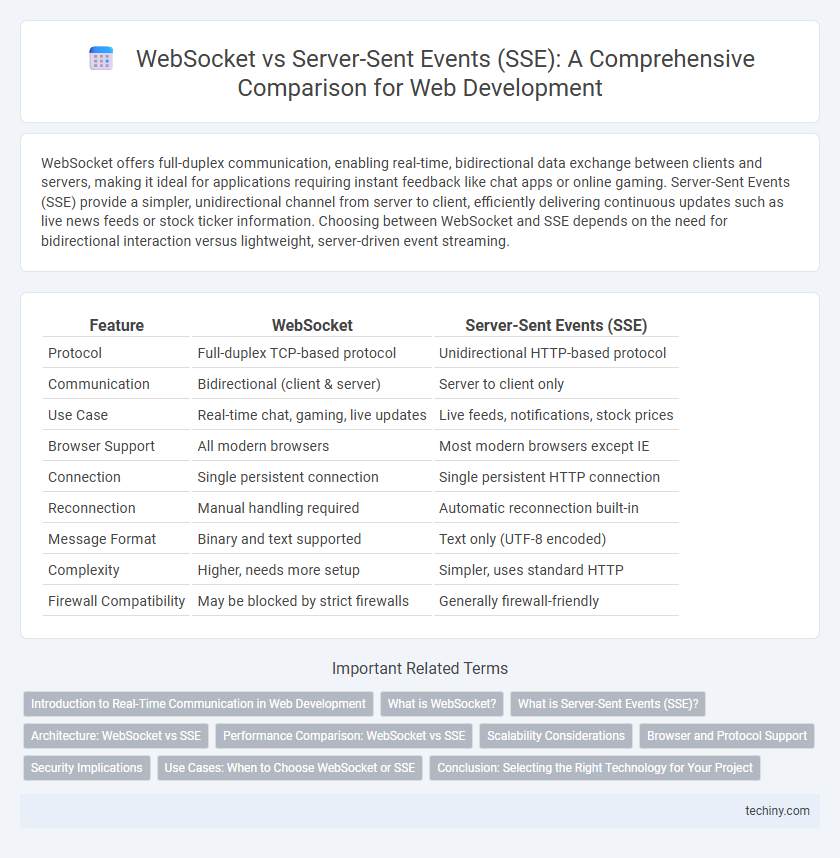WebSocket offers full-duplex communication, enabling real-time, bidirectional data exchange between clients and servers, making it ideal for applications requiring instant feedback like chat apps or online gaming. Server-Sent Events (SSE) provide a simpler, unidirectional channel from server to client, efficiently delivering continuous updates such as live news feeds or stock ticker information. Choosing between WebSocket and SSE depends on the need for bidirectional interaction versus lightweight, server-driven event streaming.
Table of Comparison
| Feature | WebSocket | Server-Sent Events (SSE) |
|---|---|---|
| Protocol | Full-duplex TCP-based protocol | Unidirectional HTTP-based protocol |
| Communication | Bidirectional (client & server) | Server to client only |
| Use Case | Real-time chat, gaming, live updates | Live feeds, notifications, stock prices |
| Browser Support | All modern browsers | Most modern browsers except IE |
| Connection | Single persistent connection | Single persistent HTTP connection |
| Reconnection | Manual handling required | Automatic reconnection built-in |
| Message Format | Binary and text supported | Text only (UTF-8 encoded) |
| Complexity | Higher, needs more setup | Simpler, uses standard HTTP |
| Firewall Compatibility | May be blocked by strict firewalls | Generally firewall-friendly |
Introduction to Real-Time Communication in Web Development
WebSocket enables full-duplex communication channels over a single TCP connection, allowing real-time bidirectional data exchange between client and server. Server-Sent Events (SSE) provide a unidirectional streaming mechanism where servers push updates to the client over HTTP. Both technologies enhance real-time web applications by reducing latency and improving user experience in scenarios like live chat, notifications, and dynamic content updates.
What is WebSocket?
WebSocket is a protocol enabling full-duplex communication channels over a single TCP connection, primarily designed for real-time web applications. It allows interactive data exchange between a client and server, reducing the overhead of HTTP requests by maintaining a persistent connection. WebSocket is widely used in chat applications, live notifications, and online gaming due to its low latency and efficient bi-directional data transfer.
What is Server-Sent Events (SSE)?
Server-Sent Events (SSE) is a web technology enabling servers to push real-time updates to browsers over a single, long-lived HTTP connection. Unlike WebSocket, SSE allows unidirectional communication from server to client, making it ideal for live feeds, notifications, and streaming data. SSE uses the EventSource API, offering automatic reconnection and simpler implementation for server-to-client messaging.
Architecture: WebSocket vs SSE
WebSocket architecture establishes a full-duplex communication channel over a single TCP connection, enabling real-time, bidirectional data exchange between client and server. In contrast, Server-Sent Events (SSE) operate on a unidirectional model, where the server pushes updates to the client over a single HTTP connection using event streams. WebSocket's persistent connection supports complex interactive applications, while SSE's simpler architecture suits scenarios requiring continuous server-to-client data flow with lower overhead.
Performance Comparison: WebSocket vs SSE
WebSocket offers full-duplex communication with lower latency and higher throughput compared to Server-Sent Events (SSE), making it ideal for real-time applications requiring rapid bidirectional data exchange. SSE operates over HTTP/1.1 with automatic reconnection and simpler implementation but often incurs higher overhead and slightly slower message delivery in high-frequency update scenarios. Performance benchmarks indicate WebSocket can handle tens of thousands of concurrent connections with less CPU usage, whereas SSE is more suitable for unidirectional streaming with moderate connection loads.
Scalability Considerations
WebSocket enables full-duplex communication, making it highly efficient for real-time applications requiring low latency, but its stateful nature demands robust server resources and can complicate horizontal scaling. Server-Sent Events (SSE) operate over HTTP/1.1 with unidirectional streaming, simplifying server infrastructure and reducing overhead, which improves scalability for applications with predominantly server-to-client updates. Load balancing and connection management strategies are critical for both technologies, but WebSocket's persistent connections typically require advanced techniques like sticky sessions or state synchronization across distributed servers.
Browser and Protocol Support
WebSockets offer full-duplex communication supported by all modern browsers, enabling low-latency, real-time data transfer with widespread protocol compatibility, including TCP. Server-Sent Events (SSE) provide unidirectional streaming updates primarily supported in Chrome, Firefox, Safari, and Edge, relying on HTTP/1.1 and HTTP/2 protocols but lacking support in Internet Explorer. WebSocket's broad browser and protocol support make it ideal for interactive applications, while SSE's simpler implementation suits scenarios requiring server-to-client event streaming.
Security Implications
WebSocket and Server-Sent Events (SSE) differ significantly in security implications, with WebSocket exposing applications to risks such as Cross-Site WebSocket Hijacking (CSWH) due to its full-duplex communication and broader attack surface. SSE operates over standard HTTP protocols, benefiting from existing web security mechanisms like CORS and simpler origin checks, reducing risks associated with persistent connections. Implementing TLS encryption (WSS for WebSocket and HTTPS for SSE) is crucial in both technologies to protect against data interception and man-in-the-middle attacks.
Use Cases: When to Choose WebSocket or SSE
WebSocket is ideal for applications requiring full-duplex communication with low latency, such as online gaming, live chat, and real-time collaboration tools. Server-Sent Events (SSE) are better suited for one-way, event-driven updates like news feeds, stock tickers, and real-time notifications where server-to-client streaming suffices. Choosing between WebSocket and SSE depends on the need for bidirectional interaction versus efficient, one-directional data flow.
Conclusion: Selecting the Right Technology for Your Project
WebSocket offers full-duplex communication ideal for real-time applications like gaming and chat, while SSE provides a simpler, unidirectional stream suited for live updates and notifications. Choose WebSocket when two-way interaction and low latency are critical, and prefer SSE for efficient server-to-client event streaming with minimal overhead. Evaluating project requirements on scalability, complexity, and browser support ensures the optimal protocol selection for enhanced performance and user experience.
WebSocket vs SSE Infographic

 techiny.com
techiny.com